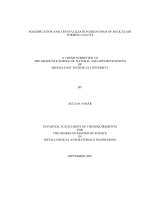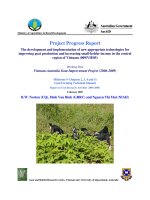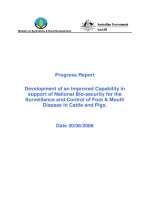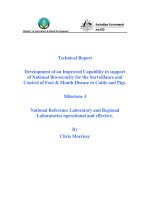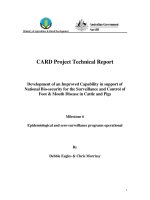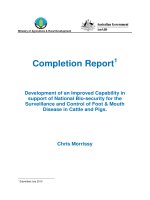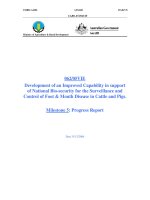Luận văn bioprospecting of haloarchaea for the development and expression of potent novel antioxidant enzymes
Bạn đang xem bản rút gọn của tài liệu. Xem và tải ngay bản đầy đủ của tài liệu tại đây (3.08 MB, 212 trang )
BIOPROSPECTING OF HALOARCHAEA FOR THE
DEVELOPMENT AND EXPRESSION OF POTENT
NOVEL ANTIOXIDANT ENZYMES
A THESIS
Submitted by
S. MURUGAN
(Reg. No. 8177)
BIOCHEMISTRY
in partial fulfillment of the requirements for the degree of
DOCTOR OF PHILOSOPHY
MANONMANIAM SUNDARANAR UNIVERSITY
TIRUNELVELI - 627 012
APRIL - 2018
MANONMANIAM SUNDARANAR UNIVERSITY
TIRUNELVELI - 627 012
CERTIFICATE
The
research
work
embodied
in
the
present
thesis
entitled
“BIOPROSPECTING OF HALOARCHAEA FOR THE PRODUCTION
AND EXPRESSION OF POTENT NOVEL ANTIOXIDANT ENZYMES”
has
been
carried
out
in
the
Department
of
Biochemistry
of
ManonmaniamSundaranaruniversity in Tirunelveli. The work reported herein is
original and does not form part of any other thesis or dissertation on the basis
of which a degree or award was conferred on an earlier occasion or to any other
scholar.
I understand the University’s policy on plagiarism and declare that the
thesis and publications are my own work, except where specifically
acknowledged and has not been copied from other sources or been previously
submitted for award or assessment.
MURUGAN. S
RESEARCH SCHOLAR
Dr. R.D. STEVENS JONES,
Dr. K.R.T. ASHA,
Co- SUPERVISOR,
SUPERVISOR,
Associate professor,
Assistant Professor
Department of Zoology,
Department of Biochemistry
Scott Christian college,
Govt. Arts College,
Nagercoil 629 003
Paramakudi -623701
Place :
Date :
i
ACKNOWLEDGEMENT
I am extremely thankful to GOD ALMIGHTY for giving me strength, health
and support for successfully completing this work at the right time.
I wish to record my deep sense of gratitude and profound thanks to my
research supervisor Dr. K.R.T. ASHA, Assistant Professor, Department of
Biochemistry, Government Arts College, Paramakudi, Ramanathapuram District,
Tamil Nadu,for her keen interest, inspiring guidance, constant encouragement with
my work during all stages, to bring this thesis into fruition.
I am extremely indebted to my joint supervisor Dr. STEVENS JONES,
Professor Department of Zoology, Scott Christian College (Autonomous) for his
valuable suggestions and support during the course of my research work.
I express my sincere thanks to Dr. Pamaela Oliver, Department of English,
Lekshmipuram College of Arts and Science, Neyyoor, Dr. A. RamalingomPillai,
Department of Chemistry, Lekshmipuram College of Arts and Science, Neyyoor for
their valuable encouragement throughout the study.
I am extremely indebted to Dr. A. Tamil Selvi, Dr. C. Sunithra,
Dr. P. NandhaKumari, Department of Zoology, Lekshmipuram College of Arts and
Science, Neyyoor,Dr. N.C.J. PackiyaLekshmi, Department of Microbiology,
Udhaya College of Arts and Science, Vellamadi, for theirvaluable suggestions and
support during the course of my research work.
I wish to express my heartfelt thanks to The Management, Principal and the
Staff members (Teaching and Non-Teaching) of Biochemistry Department of
Lekshmipuram College of Arts and Science, Neyyoor.
I am deeply indebted to my beloved Parents, Wife, Children and my family
members for their moral support and constant encouragement at every stage of this
work
S. MURUGAN
iv
LIST OF CONTENTS
Page No.
1. GENERAL INTRODUCTION WITH REVIEW OF LITERATURE
1
CHAPTER - I
2.0. ISOLATION AND CHARACTERIZATION OF
HALOARCHAEAL STRAIN
14
2.1. INTRODUCTION
2.2. MATERIALS AND METHODS
14
16
2.2.1. Sampling site
2.2.2. Collection of samples
2.2.3. Isolation and screening of Haloarchaea
2.2.4. Screening of SOD activity
2.2.5. Screening of catalase activity
2.2.6. Biochemical characterization
2.2.7. Determination ofhalophily
2.2.8. Determination of temperature in the growth of isolate
2.2.9. Determination of optimum pH
2.2.10. Determination of growth curve and generation time
2.2.11. Growth of isolate in different agars
2.2.12. Growth in various carbon sources
2.2.13. Growth in various N2sources
2.2.14. Growth in various inorganic sources
2.2.15. Growth in various organic solvents
2.2.16. Media formulation
2.2.17. Antimicrobial analysis
2.2.18. 16SrRNA Sequencing
2.3. RESULTS
16
16
17
17
17
18
21
21
22
22
22
23
23
23
24
24
24
25
27
2.3.1. Description of sampling site
2.3.2. Physico-chemical analysis
2.3.3. Isolation and screening
2.3.4. Screening of SOD producing Halobacterium
2.3.5. Screening of catalase producing strain
2.3.6. Biochemical characterization of isolate
2.3.7. Determination of halophily
2.3.8. Effect of temperature in the growth of isolate
2.3.9. Effect of pH in the growth of strain
2.3.10. Growth curve and generation time
2.3.11. Growth in different agars
2.3.12. Growth in various carbon sources
2.3.13. Effect of various carbon sources
v
27
29
31
33
33
33
34
36
38
40
41
42
43
2.3.14. Growth in various N2 sources
2.3.15. Effect of N2 sources
2.3.16. Effect of inorganic salts in the growth
2.3.17. Growth of isolate in various organic solvents
2.3.18. Effect of organic solvents
2.3.19. Antimicrobial Assay
2.3.20. 16SrRNA sequence analysis
45
46
49
50
51
52
55
2.4. DISCUSSION
2.5. CONCLUSION
59
67
CHAPTER II
3.0. PURIFICATION AND CHARACTERIZATION OF
ANTIOXIDANTENZYMES
69
3.1. INTRODUCTION
3.2. MATERIALS AND METHODS
69
73
3.2.1. Maintenance of Halobacterial culture
3.2.2. SOD production
73
73
3.2.2.1. Media for SOD production
3.2.2.2. Preparation of enzyme source
3.2.2.3. Enzyme assay
73
73
74
3.2.3. Estimation of protein
3.2.4. Purification
74
74
3.2.4.1. Precipitation by solvent
3.2.4.2. Desalting of protein
3.2.4.3. Purification by chromatography
74
75
75
3.2.5. Characterization of enzyme activity
75
3.2.5.1. Effect of pH
3.2.5.2. Effect of temperature
3.2.5.3. Effect of enzyme concentration
3.2.5.4. Effect of substrate concentration
3.2.5.5. Effect of metal ions
3.2.5.6. Effect of various buffers
3.2.5.7. Effect of inhibitors
76
76
76
76
77
77
77
3.2.6. Catalase production
78
3.2.6.1. Media formulation for catalase activity
3.2.6.2. Preparation of enzyme source
3.2.6.3. Estimation of catalase by dichromoacetic
acid method
3.2.7. Estimation of protein
3.2.8. Purification of catalase
78
78
78
79
79
3.2.8.1. Precipitation by solvent
vi
79
3.2.8.2. Purification by chromatography
3.2.9. Characterization of catalase
3.2.9.1. Effect of pH
3.2.9.2. Effect of Temperature
3.2.9.3. Effect of enzyme concentration
3.2.9.4. Effect of substrate concentration
3.2.9.5. Effect of metal ions
3.2.9.6. Effect of various buffers
3.2.9.7. Effect of inhibitors
3.3. RESULTS
79
81
81
81
82
82
82
83
83
83
3.3.1. Enzyme production in optimized medium
3.3.2. Extraction and purification of SOD
3.3.3. Characterization of enzyme
84
84
85
3.3.3.1. Effect of pH on SOD
3.3.3.2. Effect of temperature
3.3.3.3. Effect of enzyme concentration in SOD
from purified sample
89
3.3.3.4. Effect of substrate concentration in SOD activity
3.3.3.5. Effect of NaCl
3.3.3.6. Effect of metal ions in SOD Activity
3.3.3.7. Activity of SOD in various buffers
3.3.3.8. Effect of inhibitors in SOD activity
89
90
91
94
97
3.3.4. Catalase production
85
87
99
3.3.4.1. Enzyme production in optimized medium
3.3.4.2. Purification of catalase
3.3.4.3. Activity of catalase
3.3.4.4. Characterization of enzyme
3.3.4.4.1. Effect of pH
3.3.4.4.2. Effect of temperature
3.3.4.4.3. Effect of enzyme concentration
3.3.4.4.4. Effect of substrate concentration
3.3.4.4.5. Effect of NaCl
3.3.4.4.6. Effect of metal ions
3.3.4.4.7. Activity of catalase in various buffers
3.3.4.4.8. Effect of inhibitors in catalase activity
3.4. DISCUSSION
3.5. CONCLUSION
99
100
101
101
101
103
104
105
106
107
110
113
115
120
CHAPTER – III
4.0. MOLECULAR STUDIES OF ANTIOXIDANT ENZYMES
4.1. INTRODUCTION
4.2. MATERIALS AND METHODS
vii
122
122
127
4.2.1. Sample preparation
4.2.2. SDS-PAGE Electrophoresis
4.2.3. Protein identification and mass spectroscopy
4.2.4. Gene ontology by DAVID software and Protein
interaction by STRING
127
127
128
129
4.3. RESULTS
4.4. DISCUSSION
4.5. CONCLUSION
129
141
142
CHAPTER - IV
5.0 BIOACTIVITY/BIOMEDICAL APPLICATIONS OF
ANTIOXIDANT ENZYMES
143
5.1. INTRODUCTION
5.2. MATERIALS AND METHODS
143
145
5.2.1. Determination of invitroantiproliferative effect of SOD on
culturedHeLa cell lines, A-549, MCF-7, HepG2
andHt-29 cell lines
145
5.2.2. Determination of invitro cardiac protective activity of
SOD and catalase on cultured H9C2 cell lines
5.3. RESULTS
146
147
5.3.1. Determination of antiproliferative effect of SOD on
culturedHeLa cell line, A549, MCF-7, HepG2
andHt-29 cell lines
5.3.1.1. Antiproliferative effect of SOD on cultured
HeLa cell line
5.3.1.2. Invitroantiproliferative effect of SOD against
cultured MCF-7 cell lines
5.3.1.3. Determination of invitroantiproliferative effect
of SOD on cultured A-549 cell line
152
5.3.1.4. Determination of invitroantiproliferative effect
of SOD on cultured HT-29 cell line
154
5.3.1.5. Determination of invitroantiproliferative effect
of SOD on cultured Hep-G2 cell line
5.3.2. Determination of invitroantiproliferative effect of catalase on
cultured HeLa cell line, A-549, MCF-7, HepG2
andHt-29 cell lines
5.3.2.1.Determination of invitroantiproliferative effect
of catalase on cultured HeLa cell lines
5.3.2.2. Determination of invitroantiproliferative effect
of catalase on cultured A-549cell lines
5.3.2.3. Determination of invitroantiproliferative effect
of catalase on cultured MCF-7 cell lines
viii
147
147
150
156
158
158
160
162
5.3.2.4.Determination of invitroantiproliferative effect
of catalase on cultured HepG2 cell lines
5.3.2.5. Determination of invitroantiproliferative effect
of catalase on cultured HT-29 cell lines
166
5.3.3. Determination of invitro cardiac protective effect of SOD
on cultured H9C2 cell lines
5.3.4.Determination of invitro cardiac protective effect of
catalase on cultured H9C2 cells
5.4. DISCUSSION
5.5. CONCLUSION
164
168
170
172
177
SUMMARY AND CONCLUSION
178
REFERENCES
183
LIST OF PUBLICATIONS
ix
LIST OF TABLES
Table
No.
Title
Page
No.
2.1
Physicochemical characteristics of solar saltern located at
Puthalam near Kanyakumari coast of India
31
2.2
Activity of SOD in different strains
33
2.3
Activity of catalase in different strains
33
2.4
Characterization of isolated strain
34
2.5
Effect of NaCl
35
2.6
Effect of temperature in the growth of isolate
37
2.7
Effect of pH in the growth of strain
39
2.8
Growth curve of isolate
40
2.9
Growth of isolate in different agars
42
2.10
Growth of isolate in various carbon sources
43
2.11
Effect of carbon sources in the growth of isolate
44
2.12
Growth of isolate in various N2 sources
46
2.13
Effect of N2 sources in the growth of isolate
47
2.14
Effect of inorganic salts in the growth of isolate
49
2.15
Growth of isolate in various organic solvents
50
2.16
Effect of organic solvents in the growth of isolate
51
2.17
Antimicrobial activity of isolated strain
53
3.1
Activity of SOD in optimized medium
84
3.2
Activity of SOD in ice cold ethanol solvent fraction
85
3.3
Purification of SOD
85
3.4
Effect of substrate concentration in SOD activity
90
3.5
Activity of SOD in control
91
x
Table
No.
Title
Page
No.
3.6
Activity of catalase in control and optimized medium
100
3.7
Purification of catalase showing fractions
100
3.8
Activity of catalase in culture
101
3.9
Effect of substrate concentration in catalase activity
105
3.10
Activity of catalase in control
107
4.1
Mass Spectrum Analysis of Chromatogram view Band ID-I and II
132
4.2
Mass spectrum analysis of Chromatogram view Band ID-3 and 4
136
5.1
Growth inhibitory effect of SOD on HeLa cell line
148
5.2
Antiproliferative effect of SOD against cultured MCF-7 cell lines
150
5.3
Antiproliferative effect of SOD on cultured A-549 cell line
152
5.4
Antiproliferative effect of SOD on cultured HT-29 cell line
154
5.5
Antiproliferative effect of SOD on cultured Hep-G2 cell line
156
5.6
Antiproliferative effect of catalase on cultured HeLa cell lines
158
5.7
Antiproliferative effect of catalase on cultured A549cell lines
160
5.8
Antiproliferative effect of catalase on cultured MCF-7 cell lines
162
5.9
Antiproliferative effect of catalase on cultured HepG2 cell lines
164
5.10
Antiproliferative effect of catalase on cultured HT-29 cell lines
166
5.11
Cardiac protective effect of SOD on cultured H9C2 cell lines
168
5.12
Cardiac protective effect of catalase on cultured H9C2 cells
170
xi
LIST OF FIGURES
Figure
No.
Title
Page
No.
2.1
Effect of NaCl in the growth of isolate
36
2.2
Effect of temperature in growth of isolate
38
2.3
Effect of pH in the growth of strain
40
2.4
Growth curve of isolated strain
41
2.5
Effect of carbon sources in growth of isolated strain
45
2.6
Effect of N2 sources on growth
48
2.7
Effect of N2 sources on growth
48
2.8
Growth of isolate in different organic solvents
52
2.9
Antimicrobial activity of isolated strain
53
2.1
Shows 16SrRNA sequence analysis
55
2.11
Shows the sequences of 16S region of isolated strain
58
2.12
Phylogenetic relationship of isolated strain and other related
species
59
3.1
Effect of pH on SOD in crude sample
86
3.2
Effect of pH in the activity of SOD in purified sample
86
3.3
Effect of temperature in the activity of SOD from crude sample
87
3.4
Effect of temperature in the activity of SOD from purified
sample
88
3.5
Effect of enzyme concentration in SOD from purified sample
89
3.6
Michaelis-menton plot
90
3.7
Effect of NaCl
91
3.8
Activity of SOD in MnSO4
91
3.9
Effect of MgSO4
92
3.1
Effect of ZnSO4
93
3.11
Effect of bicarbonate buffer in the activity of SOD
95
3.12
Effect of glycine buffer in SOD activity
95
xii
Figure
No.
Title
Page
No.
3.13
Effect of citrate buffer in SOD activity
96
3.14
Effect of TCA in SOD activity
97
3.15
Effect of EDTA in the activity of SOD
98
3.16
Effect of SDS in the activity of SOD
99
3.17
Effect of pH in catalase activity from crude sample
102
3.18
Effect of pH in catalase from purified sample
102
3.19
Effect of temperature in catalase from crude sample
103
3.2
Effect of temperature in catalase activity
104
3.21
Effect of enzyme concentration in catalase activity
105
3.22
Michaelis-Menton plot
106
3.23
Effect of NaCl in catalase activity
106
3.24
Effect of MnSO4in catalase activity
108
3.25
Effect of MgSO4in catalase activity
108
3.26
Effect of ZnSO4 in catalase activity
109
3.27
Effect of bicarbonate buffer in catalase activity
110
3.28
Effect of glycine buffer in catalase activity
111
3.29
Effect of citrate buffer in catalase activity
112
3.3
Effect of TCA in catalase activity
113
3.31
Effect of EDTA in catalase activity
114
3.32
Effect of SDS in catalase activity
115
4.1
SDS-PAGE analysis of SOD and Catalase
130
4.2
SDS-PAGE analysis of SOD and catalase indicating bands
selected for Mass spectrum analysis
130
4.3
Chromatograph view –Band ID1
131
4.4
Chromatograph view –Band ID2
131
4.5
Protein – Protein interacting partners – kata
133
4.6
Interaction network list of proteins with Kat A
135
4.7
Chromatogram view – Band ID3
137
xiii
Figure
No.
Title
Page
No.
4.8
Chromatogram view - Band ID4
137
4.9
Protein – Protein interacting partners – soda
139
4.1
Showing the interaction network list of proteins with sod A
140
5.1
Growth inhibitory effect of SOD on HeLa cell line
148
5.2
Antiproliferative effect of SOD against cultured MCF-7 cell lines
150
5.3
Antiproliferative effect of SOD on cultured A-549 cell line
152
5.4
Antiproliferative effect of SOD on cultured HT-29 cell line
154
5.5
Antiproliferative effect of SOD on cultured Hep-G2 cell line
156
5.6
Antiproliferative effect of catalase on cultured HeLa cell lines
158
5.7
Antiproliferative effect of catalase on cultured A549cell lines
160
5.8
Antiproliferative effect of catalase on cultured MCF-7 cell lines
162
5.9
Antiproliferative effect of catalase on cultured HepG2 cell lines
164
5.1
Antiproliferative effect of catalase on cultured HT-29 cell lines
166
5.11
Cardiac protective effect of SOD on cultured H9C2 cell lines
168
5.12
Cardiac protective effect of catalase on cultured H9C2 cells
170
xiv
CHAPTER - I
2.0. ISOLATION AND CHARACTERIZATION OF
HALOARCHAEAL STRAIN
2.1. INTRODUCTION
An extremophile is an organism that thrives in physiologically or
geochemically extreme conditions that are detrimental to most life on earth
(Rampelotto, 2010). In the 1980s and 1990s, biologists found that microbial life has
an amazing flexibility for surviving in extreme environments-niches that are
extraordinarily hot or acidic. Some scientists concluded that life may have begun on
Earth in hydrothermal vents far under the ocean’s surface. On 6th February 2013,
scientists reported that bacteria were found living in the cold and dark in a lake buried
a half-mile deep under ice in Antarctica (Gorman et al., 2013). On 17th March,
researchers reported data that suggested microbial life forms thrive in the Mariana
Trench, the deepest spot on the earth (Choi et al., 2013; Glud et al., 2013). Other
researchers reported related studies that microbes thrive inside rocks upto 1900 feet
below the sea floor under 8500 feet of ocean off the coast of the northwestern United
States (Choi et al., 2013; Oskin et al., 2013). According to one of the researchers, we
can find microbes everywhere; they are extremely adaptable to conditions and survive
wherever they are (Choi et al., 2013).
Different types of halophiles have solved the problem how to hope with salt
stress (and often with other forms of stress as well) in different ways, so that the study
of microbial life at high salt concentrations can answer many basic questions on the
adaptation of microorganisms to their environments. Most known halophiles are
relatively easy to grow, and genera such as Halobacterium, Haloferax, and
14
Haloarcula have become popular models for studies of the archaeal domain as they
are much simpler to handle than methanogenic and hyperthermophilic Archaea.
Haloarchaea belongs to order Halobacteriales and family Halobacteriaceae are
dominant microorganisms requiring hypersaline environment for their growth. This
family contains 130 species of organisms (Oren et al., 2012a, 2012b; Tindall et al.,
1992) distinguished as pigmented organisms because of the presence of ruberins and
carotenoids C50 (Oren et al., 2001).
A wide variety of media are used for the cultivation of halophiles and
halotolerant bacteria. Choosing appropriate media and growth conditions is important
and published media are typically associated with a particular microbial genus or
species. Extreme halophiles are predominantly archaea and are cultured at warmer
temperatures (37˚C) with salinities of 20% or more (Schneegurt et al., 2004)
Hypersaline media can be divided into complex media that include organic
components for which exact chemical formulae are not known and defined media
where all components can be described by chemical formulae. The media for extreme
halophiles have elevated levels of magnesium and the source of water used for
preparing hypersaline media varies (Yu and Kawamura, 1987; Wais, 1988; Bertrand
et al., 1990). Filtered sea water or salt plains brine were effective bases for growing
halotolerant Cyanobacteria and algae (Henley et al., 2002; Kirkwood and Henley,
2006).
Many halophilic and halotolerant microbes isolated to date are neutrophiles,
growing best in media with pHs from 6.8 to 7.5 (Vreeland et al., 2002; Caton et al.,
2004). Anaerobes grow over a similar pH range of 6-7 (Oren 1983a, 1986; Yu and
Kawamura, 1987). Alkaliphilic organisms are grown at pHs of 8-10 (Soliman and
Truper, 1982).
15
Therefore, in this era researchers are turning their attention towards this less
explored and useful kingdom. The southern coast of Kanyakumari harbors a variety of
ecosystems for such studies; some of the areas have been already excavated while
some are underway. Hence this chapter deals with the isolation, optimization and
characterization of Haloarchaeal strain with potent antioxidant enzymes.
2.2. MATERIALS AND METHODS
2.2.1. Sampling site
The study site was Puthalam saltpans of Kanyakumari district. The total area
of the salt pan is 150 acres. This area is under the influence of very low tides and
surrounded by marshy land. The climate is generally warm and humid, fluctuating
from a minimum of 20˚C in the month of December and 42˚C in May. The salt
producing season is normally during the non-monsoon months. Each pan is
surrounded by ‘bandhs’ or mud borders on all four sides which prevent siltation and
facilitate to regulate the flow of water. Water gets heated up and evaporates with
crude salt. In the peak salt producing season, salt is harvested and collected daily. The
physico-chemical characterization of water samples were analyzed according to
Abbasi, 1988.
2.2.2. Collection of samples
Water samples were collected from the saltpan at 3 different sites. The
collected samples were transferred to sterile polythene bags to prevent direct contact
with air and were transported to the laboratory in an ice box for further examination.
16
2.2.3. Isolation and screening of Haloarchaea
The water samples were serially diluted by taking 1 ml from the mixed water
sample and a total of ten dilutions (10-1 to 10-10) were made by sea water. The 10-6
dilution was used for plating on Zobell marine agar plates by spread plate method.
The plates were incubated at 37°C for 12 days (Brown Petersen et al., 1993). Pure
bacterial isolates were obtained by repeated sub culturing on marine agar plates, and
were stored in agar slants with the help of 15% glycerol.
2.2.4. Screening of SOD activity
The isolated halobacterial strains were inoculated in conicalflask containing
marine broth supplemented with 2% pyrogallol and incubated the flask in water bath
with shaker at 37˚C for 12 days. Supernatant was obtained from the early stationary
phase culture by centrifuging the culture broth at 3000 rpm for 10 minutes. The
supernatant obtained was used as enzyme source.
The 2% pyrogallol in 0.05M Tris HCl buffer at pH 7.5 acts as the substrate.
The SOD activity was assayed by using Marklund and Marklund method (1974). The
halobacteria with maximum SOD activity was screened using the assay procedure.
2.2.5. Screening of catalase activity
The isolated halobacterial strains were inoculated in concical flask containing
marine broth with 2% hydrogen peroxide. The flask was incubated in water bath with
shaker at 37ºC for 12 days. The early stationary phase culture was taken and
centrifuged at 3000 rpm for 10 minutes. The supernatant obtained was used as
enzyme source. The 2% H2O2 in 0.05M Tris HCl buffer at pH 7.5 acts as the
substrate. The catalase activity was assayed by using dichromoacetic acid method
(Arsu K. Sinha, 1972).
17
2.2.6. Biochemical characterization
The culture characterization was identified by performing the biochemical
tests such as gelatinase production test, cellulase production test, catalase test, oxidase
test, urease test, H2S production test, gas production test, Indole production test,
carbohydrate test, nitrate reduction test, citrate utilization test, Gram staining and
motility test.
2.2.6.1. Gelatinase production test
The organism was inoculated in the gelatin agar (Himedia) and incubated for
12 days at 37˚C. After incubation, 0.1 % mercuric chloride solution was added and
allowed to stand for 5-10 minutes. Formation of clear zone around the colony
indicated positive result.
2.2.6.2. Cellulase production test
The isolates were inoculated in the Czapek medium (Himedia) (CM)
supplemented with NaCl. After incubation, the plates were flooded with 1ml solution
of hexaethyltrimethyl sulphate. The plates, which showed clear zone around the
growth, were considered as cellulase positive.
2.2.6.3. Catalase test
Agar slant was inoculated with the test culture and was incubated at 37˚C for
12 days, 1ml of 2% hydrogen peroxide was added to flow down the slant and was
examined immediately and after 5 minutes for the evolution of bubbles which
indicated positive test.
18
2.2.6.4. Oxidase test
Strips of whatman No.1 filter paper was soaked in a freshly prepared 1%
solution of tetramethyl paraphenyl diamine dihydrochloride and dried in oven at 40˚C.
The isolate was streaked on it with sterile platinum loop. An intense deep purple
colour appearance within 5 – 10 seconds indicated positive reaction, and a negative
reaction indicated by the absence of colouration.
2.2.6.5. Urease test
Urease is a hydrolytic enzyme that attacks the nitrogen and carbon bonds in
amide compounds like ammonia and urea and releases alkaline end product such as
ammonia. The bacterial culture was inoculated in Christensen’s agar slant and
incubated at 37˚C and the reaction was recorded after 4, 8, and 12 days of incubation.
The production of enzyme urease was detected by a change in colour of the medium
from yellow to purple.
2.2.6.6. H2S production test
TSI (Triple Sugar Iron Test) was used to differentiate different group of
Enterobacteriaceae from other gram negative bacilli. The TSI slants contain 1% each
of lactose, sucrose and glucose 0.1%. The phenol red acid base indicator was
incorporated in the medium to detect carbohydrate fermentation.
The bacterial isolate was inoculated in the TSI agar slant by stabbing the butt
down to the bottom and then streaking the surface of the slant, incubated at 37˚C for
7 – 12 days. The result would be either of following three types.
19
a. Acid butt, alkaline slant (yellow butt, red slant) – glucose has been fermented
but either lactose or sucrose.
b. Acid butt, acid slant (yellow butt, red slant) – lactose and / or sucrose has been
fermented.
c. Alkaline butt, alkaline slant (red butt, red slant) – either glucose or lactose or
sucrose has been fermented.
Gas production : indicated by bubbles in the butt or the agar may be broken or
pushed upwards.
2.2.6.7. Indole production test
Tryptone broth tubes were prepared and sterilized at 121˚C for 15 minutes.
The culture was then inoculated and incubated at 37˚C for 7 – 12 days. After the
incubation, a few drops of (0.2 ml) Kovac’s reagent was added into the tubes and the
result was observed. The development of bright red colour at the interface of reagent
and medium indicated the positive result. The absence of colour change at this
interface indicated the negative test.
2.2.6.8. Carbohydrate test
The bacterial species isolated were checked for their ability to ferment various
carbohydrates (lactose, mannitol, sucrose and dextrose). Oxidation – fermentation
basal medium was prepared with 1% of different sugars each and sterilized.
Inoculated for 2 or 3 loopful of 7 – 12 days old broth culture into sterile fermentation
medium and incubated for 24 – 48 h at 30˚C. Change in the colour of the medium to
yellow indicates acid reaction.
20
2.2.6.9. Nitrate reduction test
Nitrate broth (HiMedia) was prepared and 5ml was dispensed in the test tubes.
The isolates were inoculated into nitrate broth. The tubes were then incubated at 37˚C
for 96 hours. After incubation, 0.1 ml of sulphanilic acid and alpha naphthalamine
was added and mixed well. Finally, the results were observed.
2.2.6.10. Citrate utilization test
Simmon’s citrate agar was prepared and dispensed on test tubes and sterilized
at 121˚C for 15 minutes and allowed to set as slants. The cultures were then
inoculated into the tubes containing Simmons citrate agar slants (Stabbed into the bud
and streaked on the surface of slants) and incubated at 37˚C for 7 – 12 days. After the
incubation period, the development of intense blue colour from the original green
colour of the medium indicated the ability of the organism to utilize citrate as carbon
source and constituted the positive reaction. The absence of blue colour indicates the
negative reaction.
2.2.7. Determination of halophily
In order to determine the halophily, the broth culture was supplemented with
NaCl of different concentrations (g/dL) at 25%, 26%, 27%, 28%, 29%, 30% and
incubated at 37oC for 12 days in a rotary shaker at 120 rpm. The growth rate was
obtained by recording O.D values at 540 nm. Based on the growth characteristics, the
optimum salinity requirement for the strain was arrived by extrapolating the graph.
2.2.8. Determination of temperature in the growth of isolate
In order to find out the optimum temperature requirement of strain, the isolate
was grown at different temperatures from 37oC to 43oC for 12 days. The growth rate
21
was obtained by recording O.D values at 540 nm. The temperature required for the
strain was calculated by extrapolating the graph.
2.2.9. Determination of optimum pH
Optimization of pH value for the growth rate of specific strain was determined
at different pH values 8.0, 8.4, 8.8 and 9.2. The isolate was inoculated and incubated
in Zobell marine broth at 37oC for 12 days. The growth rate was obtained by
recording O.D values at 540 nm. Based on the observed growth characteristics, the
optimum pH required for the strain was calculated by extrapolating the graph.
2.2.10. Determination of growth curve and generation time
The generation time of isolated strain was determined by inoculating the
isolate in marine broth at 0, 1, 2, 3, 4, 5, 6, 7, 8, 9, 10, 11, and 12 days at 37˚C and
kept in rotary shaker at 120 rpm. The growth rate was obtained by recording O.D
values at 540 nm. Based on the growth characteristics, the generation time was
calculted from the extrapolation of the graph.
2.2.11. Growth of isolate in different agars
The isolated halobacterial strain was inoculated in different agars such as
casein hydrolysate agar, starch agar, potato dextrose agar, Rose Bengal agar,
Macconkey agar, Zobell marine agar, Blood agar, Gelatin agar and EMB agar to
analyze its effective growth. All the agars were supplemented with 25% NaCl. The
inoculated strains in different agars were incubated at 37oC for 12 days.
22
2.2.12. Growth in various carbon sources
In order to determine the growth rate, the isolated strain was inoculated on
Zobell marine agar plates supplemented with various carbon sources such as glucose,
fructose, lactose, starch, maltose, galactose and sucrose separately. The plates were
incubated at 37oC for 12 days. Broth cultures were also prepared by inoculating the
strain into Zobell marine broth along with the above sources in different
concentrations (glucose: 1-10%, fructose: 1-6%, lactose: 1-5%, starch: 1-11%,
maltose: 1-5%, galactose: 1-7% and sucrose: 1-6%). The growth rate of the strain was
obtained by recording OD values at 540nm.
2.2.13. Growth in various N2 sources
In order to increase the growth rate the isolated strain was inoculated in Zobell
marine agar plates supplemented with various N2 sources such as tryptophan, tyrosine,
arginine, cysteine, methionine, histidine, glycine and proline (w/v) individually. The
plates were incubated at 37oC for 12 days. Broth cultures were also prepared
individually by inoculating the strain into Zobell marine broth along with the above
sources (tryptophan: 0.5-2.0%, tyrosine: 0.5-2%, arginine: 0.2-1.0%, cysteine:
0.5-2.0%, histidine: 0.2-1.2% and glycine: 0.2-1.0%). The growth rate of the strain
was obtained by recording OD values at 540nm.
2.2.14. Growth in various inorganic sources
The growth rate of isolated strain was studied by supplementing the marine
agar plates with inorganic sources such as BaCl2, Lead acetate, MnCl2, Mercuric
chloride, Nickel sulphate, CaCl2, FeSO4, ZnSO4, Potassium thiosulphate, CuSO4,
Ferrous ammonium sulphate, Sodium sulphate, Lithium carbonate, MgSO4 and KCl at
a concentration of 0.5gm (w/v) were used. The plates were incubated at 37˚C to
evaluate the optimum growth by recording OD values at 540nm.
23
2.2.15. Growth in various organic solvents
In order to determine the efficacy of organic solvent, the isolated strain was
inoculated in Zobell marine agar plates and broth supplemented with different
concentrations of organic solvents such as, methanol (1-5% (v/v)), ethanol (1-7%
(v/v)), chloroform (1-6% (v/v)), diethyl ether (1-7% (v/v)) and acetone. The results
were recorded by taking OD values at 540nm.
2.2.16. Media formulation
A semi synthetic medium was used for the general cultivation of the isolated
strain.The selective medium containing marine broth (4gm), NaCl (29gm), Fructose
(1gm), Glucose (1gm), Sucrose (1gm), Galactose (1gm), Maltose (1gm), Lactose
(1gm), Cysteine (0.5gm), Histidine (0.5gm), Arginine (0.5gm), Glycine (0.5gm),
Tryptophan (0.5gm), pH (8.8), agar (15gm) in 100ml of distilled water.
2.2.17. Antimicrobial analysis
The supernatant liquid collected from the broth was subjected to antimicrobial
activity against E.coli, Staphylococcus aureus, Klebsiella sps, Pseudomonas
aeroginosa, Enterobacter sp., and Proteus vulgaris by standard paper disc assay
method (Acar, 1980). Whatman No.1 filter paper discs (5 mm diameter) were
autoclaved for 15 minutes at 121˚C. The sterile discs were loaded with crude culture
supernatant (50µl/disc). Agar plates were spreaded uniformly with the suspension of
bacterial strains. The discs with supernatant were placed on the agar plate. A disc
loaded with Chloramphenicol was used as control. The agar plates were incubated at
37˚C for 48 hours. The diameter of bacterial growth inhibition zone around each disc
was examined under transmitted light source.
24
2.2.18. 16S rRNA Sequencing
DNA purification kit (PureFast® Bacterial Genomic DNA purification kit),
PCR Master Mix, Agarose gel electrophoresis consumables and Primers purchased
from HELINI Biomolecules, Chennai, India.
2.2.18.1. 2X Master Mix
It contains 2U of Taq DNA polymerase, 10X Taq reaction buffer, 2mM
MgCl2, 1μl of 10mM dNTPs mix and PCR additives.
2.2.18.2. Agarose gel electrophoresis
Agarose, 50X TAE buffer, 6X gel loading buffer and Ethidium bromide are
purchased from HELINI Biomolecules, Chennai.
2.2.18.2.1. Procedure
Pellet was suspended in 200μl of PBS, added 50μl of lysozyme and incubated
at 37ºC for 15min. 400μl of Lysis buffer and 40μl of Proteinase K [10mg/ml] were
added and gently mixed well, incubated in water bath at 70°C for 10 min. Transferred
the whole lysate into purefast spin column and centrifuged at 10000 rpm for 1min.
Discarded the flow through and added 500μl of wash buffer and centrifuged at
10000rpm for 1 min. Discarded the flow through and added 500μl of wash buffer-2
and centrifuged at 10000rpm for 1min. Repeated the same procedure for one more
time. Discarded the flow through and centrifuged the column for 2 minutes more to
remove the residual ethanol. Eluted the DNA by adding 100μl of elution buffer and
centrifuged for 1min. Qualitative and quantitative examination of extracted DNA was
carried out by loading in 1% agarose gel and 1μl of extracted DNA was used for PCR
amplification.
25

